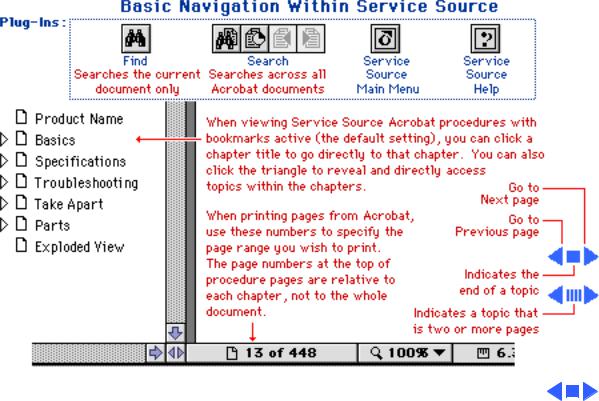Apple PowerBook 550c Service Manual

K Service Source
Macintosh PowerBook 550c
This product is forJapan only.


K Service Source
Basics
Macintosh PowerBook 550c

Basics |
General Information - 1 |
|
|
|
|
General Information
The Macintosh PowerBook 550c features a built-in trackpad, intelligent batteries, two battery bays, an optional PCMCIA expansion module, a darker shade of plastics, and a 10.4" display. The computer is available in Japan only.

Basics |
Rear Panel - 2 |
|
|
|
|
Rear Panel
The illustration below shows the location of ports and connectors on the rear panel of the Macintosh PowerBook 550c.

Basics |
PB Screw Matrix - 3 |
|
|
|
|
PB Screw Matrix
Nine different types of screws are used in the Macintosh
PowerBook 550c. All are Torx screws and require either a
T-8 or T-6 Torx screwdriver.
Note: The legend for the screws follows on the next page.

Basics |
PB Screw Matrix - 4 |
|
|
|
|
Legend for Macintosh PowerBook 550c Screws
1Feet
2Hard drive, keyboard, bottom case (middle front), display assembly, floppy drive, daughterboard EMI shield (top edge), inside edge of top case, right side panel
3Display bezel, display, clutch, DAA
4Trackpad cable and actuator, daughterboard EMI shield (sides), motherboard standoff
5Rear panel
6Hard drive bracket
7Inverter board, interconnect board
8Bottom case (front corners), left side panel
9Floppy drive bracket

Basics |
PB Cable Matrix - 5 |
|
|
|
|
PB Cable Matrix
For a matrix of cables that work with specific models of the PowerBook family of computers, refer to the PowerBook Cable Matrix. (The Macintosh PowerBook 550c uses the same cables as the Macintosh PowerBook 520/540 Series.)

Basics |
PCMCIA Module Handling - 6 |
|
|
|
|
PCMCIA Module Handling
The PCMCIA (Personal Computer Memory Card International Association) expansion module is an option for the Macintosh PowerBook 550c. The module inserts into the computer’s second (left) battery bay and has two slots that accept a variety of third-party PCMCIA cards.
There are three types of PCMCIA cards: Type I (3 mm), Type II (5 mm), and Type III (10 mm). Type I and Type II cards fit in either the upper or lower slot of the expansion module. Type III cards fit in the lower slot and take up both slots.
The following are guidelines for properly handling the PCMCIA expansion module:
• Do not insert or remove the PCMCIA expansion module while the computer is on or in Sleep mode. if you do, the

Basics |
PCMCIA Module Handling - 7 |
|||
|
|
|
||
|
computer will shut down and all RAM contents will be |
|||
|
lost. |
|||
|
• Eject the PCMCIA module using the lever at the front of |
|||
|
the module; eject a PCMCIA card using the PCMCIA Eject |
|||
|
control panel or the PCMCIA Quick Eject module in the |
|||
|
computer’s Control Strip. |
|||
|
• Keep the protective cap that comes with the module and |
|||
|
place it back on the module when it is not in use. |
|||
|
• Do not open the module or insert anything other than a |
|||
|
PCMCIA card into the card slots. |
|||
|
• Keep the module in a safe place, away from small objects |
|||
|
that might fall into it. |
|||
|
• Before ejecting a PCMCIA card, make sure nothing is |
|||
|
blocking the card’s slot. To immediately reinsert the |
|||
|
card, pull it out an inch more and then push it back in. |
|||
|
• Use only cards that are compatible with the PCMCIA |
|||
|
expansion module. Refer to the compatibility |
|||
|
information that came with the card. |
|||
|
|
|
|
|
|
|
|
|
|

Basics |
Battery Handling - 8 |
|
|
|
|
Battery Handling
The Macintosh PowerBook 550c includes two nickel- metal-hydride (NiMH) batteries. Each battery provides power for up to 3.5 hours of work time, depending on the battery conservation features employed. A smart processor included in each battery pack indicates the battery’s charge status.
±Warning: NiMH batteries contain toxic materials. Send undamaged, dead batteries to Apple for recycling—do not discard dead batteries with other waste. If the battery is damaged, do not return it to Apple. Dispose of damaged batteries according to local ordinances. Review batteryhandling and disposal instructions in Bulletins/Safety.

Basics Battery Handling - 9
The following are guidelines for properly handling the
Macintosh PowerBook 550c battery:
• Handle the battery carefully. Do not drop, puncture, disassemble, mutilate, or incinerate it.
• Do not short-circuit the battery terminals.
• Do not leave a battery in the computer for longer than a week without plugging in the power adapter.
• Do not leave the battery in hot locations (such as the trunk of a car).
• Keep the battery in a cool, dark place; do not store it for longer than 6 months without recharging.
• If you are using one battery: Completely discharge and then recharge the battery once every 90 days.
• If you are using two batteries: Swap the left and right batteries every month.
• Fully charge a replacement battery before using it; Apple ships batteries in a partially charged state.

Basics |
Battery Verification - 10 |
|
|
|
|
Battery
Verification
Negative
Probe Positive
Probe
The Control Strip on the Macintosh PowerBook 550c desktop shows the battery charge and the rate at which the battery is being used. Use a voltmeter to measure the actual battery charge:
• Set the voltmeter to the 10 volts DC scale.
• Hold the positive probe of the voltmeter to the positive battery terminal and the negative probe to the negative terminal.

Basics |
Battery Verification - 11 |
|||
|
|
|
||
|
• A fully charged battery |
|||
|
measures approximately |
|||
|
10.8 volts; a fully |
|||
|
discharged battery |
|||
|
measures 7.8 volts. |
|||
|
Note: If a battery is stored |
|||
|
outside the computer for |
|||
|
extended periods, its voltage |
|||
|
may drop to 5.0. |
|||
|
|
|
|
|
|
|
|
|
|

Basics |
Adapter Verification - 12 |
|
|
|
|
Adapter
Plug
Negative
Probe
Positive
Probe
Adapter
Verification
To verify the charge of the AC adapter,
• Plug in the AC adapter to a wall socket.
• Set a voltmeter to the 10 volts DC scale.
• Touch the positive voltmeter probe to the inside of the adapter plug and touch the negative voltmeter probe to the outside of the plug. If the reading is not 16 volts, replace the adapter.

K Service Source
Specifications
Macintosh PowerBook 550c

|
Specifications |
Processor - 1 |
|||
|
|
|
|
||
|
|
Processor |
|||
CPU |
Motorola 68040 microprocessor |
||||
|
|
66/33 MHz |
|||
Addressing |
32-bit internal registers |
||||
|
|
32-bit address bus |
|||
|
|
32-bit data bus |
|||
|
|
|
|
|
|
|
|
|
|
|
|

Specifications |
Memory - 2 |
|
|
|
|
RAM
ROM
PRAM
VRAM
Clock/Calendar
Memory
4 MB RAM installed on the daughterboard
Expandable to 12 MB with 8 MB Apple RAM expansion card Expandable to 36 MB with third-party RAM expansion card
2 MB
256 bytes of parameter memory
512K of static video display memory
CMOS custom chip with long-life lithium battery

Specifications |
Disk Storage - 3 |
|
|
|
|
Disk Storage
Floppy Drive
Hard Drive
15 mm high, internal, 1.4 MB Apple SuperDrive
2.5 in., 750 MB hard drive

Specifications |
I/O Interfaces - 4 |
|
|
|
|
SCSI
Apple Desktop Bus
Serial
Sound
I/O Interfaces
HDI-30 SCSI port with 1.5 MB/sec. transfer rate Supports up to six external SCSI devices
Connect SCSI device to computer with HDI-30 SCSI system cable.
Apple Desktop Bus (ADB) port
200 mA maximum current draw for all ADB devices RS-422 serial port; mini DIN-8 connector
Stereo sound-in port
Stereo sound-out headphone jack; standard 3.5 mm stereo miniplugs

|
Specifications |
I/O Interfaces - 5 |
|
|
|
|
|
Video |
Micro DV-14 video-out port; 8 bit, 256 color video output |
||
|
|
Supports most Macintosh, VGA, and SVGA monitors |
|
Ethernet |
High-speed Ethernet port; Apple AUI connector |
||
Processor-Direct Slot 90-pin processor-direct slot (PDS) for PDS devices or optional |
|||
|
Personal Computer Memory Card International Association |
||
|
(PCMCIA) adapter/PCMCIA expansion module (allows use of |
||
|
two Type II or one Type III PCMCIA-type card) |
||
Power Adapter |
Power adapter port |
||
Modem |
Slot for optional internal modem |
||
Security |
Slot for third-party security equipment |
||
|
|
|
|
|
|
|
|

 Specifications I/O Devices - 6
Specifications I/O Devices - 6
|
I/O Devices |
Keyboard |
Built-in keyboard with 12 function keys |
|
76 keys domestic, 77 keys ISO |
|
Two-level tilt adjustment |
Trackpad
Microphone
Solid-state trackpad
Electret, omnidirectional
Output voltage of 4 mV, peak to peak

Specifications |
Sound and Video - 7 |
|
|
|
|
Sound and Video
Sound Generator
Apple sound chip provides 16-bit sound capable of driving stereo headphones or other stereo equipment through the sound jack
Built-in stereo speakers
Video Display
10.4-in. diagonal screen
Backlit, active-matrix color display; 640 x 400 pixels at thousands of colors; 640 x 480 pixels at 256 colors

Specifications |
Electrical - 8 |
|
|
|
|
Electrical
Main Battery
Two nickel-metal-hydride (NiMH) batteries
Up to 3.5 hours of usage per battery before recharging
Recharge time: 2 hours in shut down or sleep mode, 4 hours while computer is running
Power Adapter
110–240 VAC line voltage 40 W, 50–60 Hz

|
Specifications |
Physical - 9 |
|||
|
|
|
|
||
|
|
Physical |
|||
Dimensions |
|
|
|
|
|
Height |
2.25 in. (5.7 cm) |
||||
Width |
11.5 in. (29.2 cm) |
||||
Depth |
9.65 in. (24.5 cm) |
||||
Weight |
7.3 lb. (3.3 kg) |
||||
|
|
|
|
|
|
|
|
|
|
|
|

Specifications |
Environmental - 10 |
|
|
|
|
Environmental
Operating
Temperature
Storage
Temperature
Relative Humidity
Operating Altitude
Storage Altitude
50–104°F (10–40°C)
-13 to 140°F (-25 to 60°C)
20–80% noncondensing 0–10,000 ft. (0–3048 m) 0–15,000 ft. (0–4572 m)

Specifications |
Other - 11 |
|
|
|
|
Internal Modem
SCSI Adapter
PCMCIA Module
Other
Sends and receives data at 19.2 bps; sends and receives faxes at 14.4 bps
Enables connection between PowerBook computer and desktop Macintosh (PowerBook appears as a hard drive on the desktop)
Enables use of two Type I or II PCMCIA cards or one Type III card

K Service Source
Troubleshooting
Macintosh PowerBook 550c

Troubleshooting |
General - 1 |
|
|
General
The Symptom Charts included in this chapter will help you diagnose specific symptoms related to your product. Because cures are listed on the charts in the order of most likely solution, try the first cure first. Verify whether or not the product continues to exhibit the symptom. If the symptom persists, try the next cure. (Note: If you have replaced a module, reinstall the original module before you proceed to the next cure.)
If you are not sure what the problem is, or if the Symptom Charts do not resolve the problem, refer to the Flowchart for the product family.
For additional assistance, contact Apple Technical Support.

Troubleshooting |
Power Manager Reset - 2 |
|
|
Power Manager Reset
Reset the power manager if
•The battery and power adapter are proven good, but the computer will not power on.
•The computer will not reset after a system crash.
To reset the power manager in the Macintosh PowerBook 550c,
•Remove the AC adapter and the battery.
•Let the unit sit without power hooked up for 3–5 minutes.
•Simultaneously hold down the Control, Command, Option, and Power On keys for 5–10 seconds.
•Reinstall the battery and, if necessary, reconnect the AC adapter.
•Turn on the computer.
